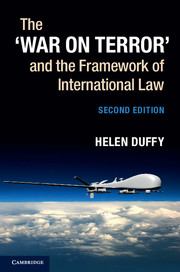Book contents
- Frontmatter
- Dedication
- Contents
- Preface to the second edition
- Preface to first edition
- Select table of cases
- Select table of treaties
- Select Table of resolutions, reports and other sources
- Select list of abbreviations and acronyms
- 1 Introduction
- Part I Terrorism and responsibility
- Part II Responding to terrorism: legal framework and practice
- Part III Case Studies
- Select bibliography
- Index
Preface to the second edition
Published online by Cambridge University Press: 05 April 2015
- Frontmatter
- Dedication
- Contents
- Preface to the second edition
- Preface to first edition
- Select table of cases
- Select table of treaties
- Select Table of resolutions, reports and other sources
- Select list of abbreviations and acronyms
- 1 Introduction
- Part I Terrorism and responsibility
- Part II Responding to terrorism: legal framework and practice
- Part III Case Studies
- Select bibliography
- Index
Summary
Much has changed since 2004, when the first edition of this book was completed. Global anti-terrorism practice has ballooned. Legal, policy and structural developments on the national, regional and international levels have created an elaborate architecture around security and counter-terrorism, while at times challenging fundamental rules of the international legal order. In turn, political, judicial and other responses to counter-terrorism measures have emerged, of potentially critical significance to the long-term implications of the war on terror. While the legal framework may not have undergone the transformative shift some heralded post-9/11, one result is undoubtedly a more elaborate body of law governing terrorism and counter-terrorism. This legal framework sits alongside a vastly expanded body of practice, which continues to grow and to spread its reach, assuming new forms and embracing broader ranges of behaviour under the banner of security and counter-terrorism. Given the nature and extent of developments in this area, this edition inevitably varies from the first edition in significant respects.
The book maintains as its key objective the identification and exploration of the current international legal framework governing terrorism and counter-terrorism. Many years into post 9/11 counter-terrorism practice, it takes into account how, in a particularly dynamic field of practice, the legal framework has itself been shaped and influenced by post-9/11 practice. Alongside consideration of the legal framework, it highlights and illustrates counter-terrorism practices that have unfolded, and issues of international legality that have arisen, during the thirteen years of practice since 9/11. Some of this practice represents clear violation – or perhaps the marginalisation – of the legal framework explained in the book; some raises novel legal questions to be grappled with regarding the application of the law or whether there are gaps or tensions in the framework itself.
- Type
- Chapter
- Information
- The ‘War on Terror' and the Framework of International Law , pp. xxv - xxviiiPublisher: Cambridge University PressPrint publication year: 2015

